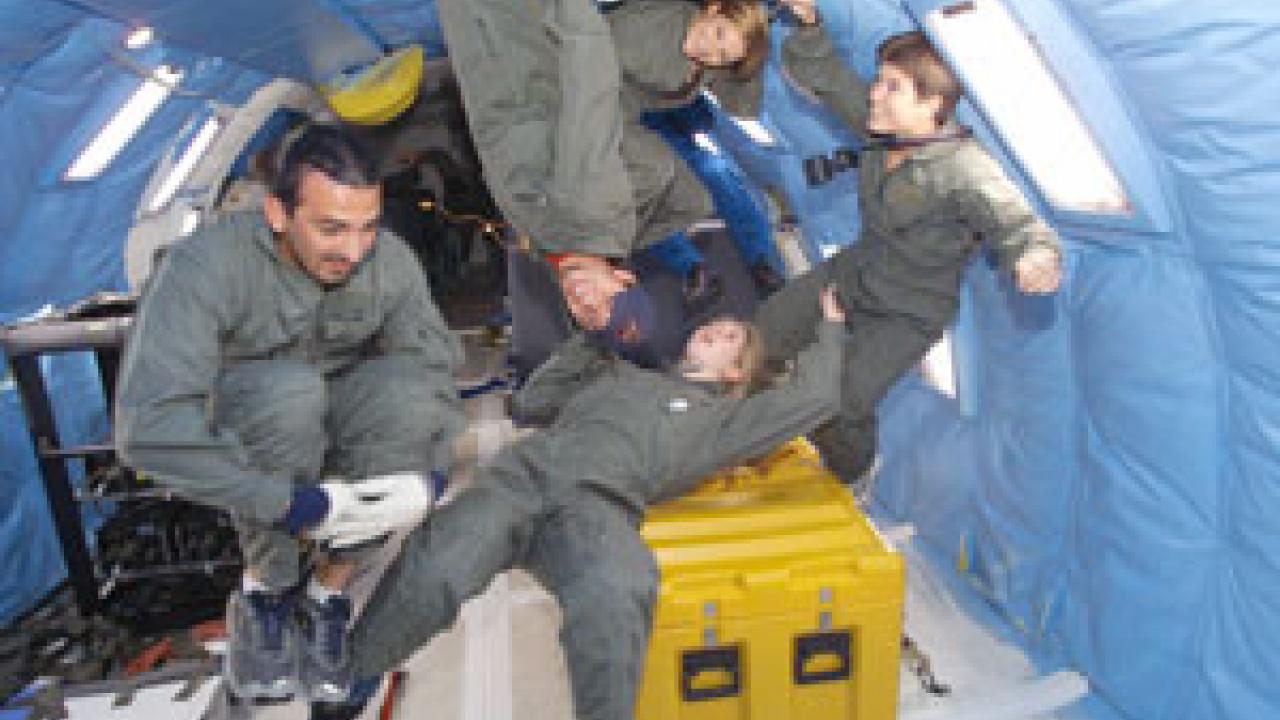Four UC Davis students were walking on air recently -- literally. They got a taste of weightlessness when they took their experiments aboard a NASA aircraft that simulates zero-gravity conditions for 25 seconds at a time.
"It's indescribable," said Daniela Fredrick. "Weird, but pleasant, and fun."
"It's very addictive, you immediately want to do it again," said Cosan Unuvar.
Fredrick and Unuvar, both graduate students in the UC Davis Department of Chemical Engineering and Materials Science, with undergraduate Jennifer Sween, UC Davis alumna Laurie Harvey and Anthony Manerbino from Canadian engineering company Guigne International, were carrying out experiments aboard NASA's "Weightless Wonder," less politely known as the "Vomit Comet."
The converted KC-135 is used by NASA for astronaut training and to carry out experiments requiring short periods of reduced gravity. To achieve that, the plane flies a series of rollercoaster climbs and dips. As the plane goes over the top of the climb, the apparent gravity on board drops to about one percent of normal. As it pulls out of its dive, the force rises to 2 G, or double normal. The plane makes 40 such maneuvers per flight.
The UC Davis team is studying formation of new materials by combustion in an electric field. A mixture of metal powders is ignited at one end, causing a wave of combustion to pass through it at temperatures up to 1500 degrees Celsius. New materials form behind the wave front. Passing an electrical current through the mixture makes the process more efficient and can create new materials with unique properties, especially nanomaterials made up of extremely small crystals.
Because molten material flows under gravity, the results are different depending on whether the sample is ignited from the top or the bottom. Doing the experiments in a low-gravity environment should sharpen the effect of the electric field, said Zuhair Munir, professor of chemical engineering and materials science and principal investigator on the project.
The work could lead to new ways to manufacture new types of materials, Munir said.
The work is funded by a grant from NASA to Munir and Ben Shaw, professor of mechanical and aeronautical engineering.
The students have spent much of the past few months carrying out experiments on the ground and preparing technical and safety documentation for NASA, and there was no let up when they arrived at the Johnson Space Center in Houston, Texas, in early November. Two thousand pounds of equipment needed to be unpacked, prepared and installed on the aircraft. "You can't check things enough," Unuvar said.
Once in the air, the team had to prepare for the first experiment, get into position --and found weight dropping away, somewhere over the Gulf of Mexico. "Your first reaction is that you're trying to swim in the air and nothing happens - your legs are spinning like a cartoon character," Unuvar said.
"You're just smiling the whole time," said Fredrick. "It's totally different from a rollercoaster, or anything else."
The nearest equivalent, in terms of the uniqueness of the experience, was scuba-diving, Fredrick said. Despite the plane's nickname, none of the group got sick.
"It's too much fun to get sick," Unuvar said.
As weight returned, then doubled, the team had to remove the spent combustion chamber and fit a new one. At the bottom of the dip the 9-pound chambers weigh nearly 20 pounds and it's impossible to stand up. But changeovers went better than expected and the students were able to complete their experiments with time to spare to enjoy the experience.
They completed four flights and 158 parabolic maneuvers. The students will now repeat the experiments on the ground, but hope to go on some more flights next year.
For video clips of the students performing experiments aboard the "Weightless Wonder," see http://www.news.ucdavis.edu/multimedia/Media Resources
Andy Fell, Research news (emphasis: biological and physical sciences, and engineering), 530-752-4533, ahfell@ucdavis.edu
